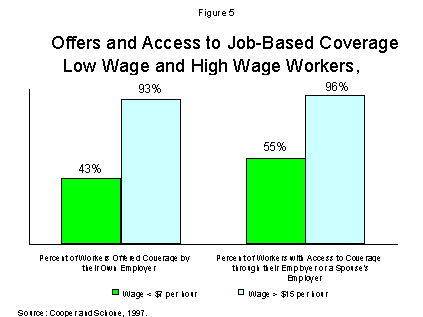How Well Does the Employment-Based Health Insurance System Work for Low-Income Families? – Issue Paper
How Well Does the Employment-Based Health Insurance System Work for Low-Income Families?
September 1998
Most Americans receive health insurance coverage through the workplace. Unfortunately, however, many workers are left out, especially low-wage workers and their families. Being a low paid worker does not mean just that wages are low. It also means a lower likelihood of receiving health insurance protection on the job. Low-wage workers have never been as likely as the better paid to get coverage from their employers. And, as employers try to limit what they spend on coverage, the gap is growing worse. Although recent employer actions have reduced coverage for workers at all wage levels, low-wage workers have been the hardest hit.
Medicaid has made an enormous difference to health insurance protection for low-income families. But Medicaid eligibility is limited to the poorest of the poor, especially mothers and children. Although Medicaid has been expanded in recent years to reach near-poor pregnant women and children, many low-income working families have not been eligible for coverage. Employer protection is therefore critical for workers with low and modest incomes.
The purpose of this Issue Paper is to describe the nature of employer coverage; its decline, especially among low-wage workers and low-income families; and the factors that are undermining its reach. In summary, this paper documents the following:
Low wage workers are least likely to have employer coverage.
- Whether they work in large or small firms, low-wage workers are far less likely than the better paid to have employer coverage. Although 90% of the highest wage workers had employment-based health insurance in 1996, only 42% of the lowest wage workers were covered.
- The primary reason low-wage workers lack coverage is that their employers do not offer them health insurance benefits. Despite substantial costs, most low-wage workers (76% in 1996) participate in employer plans to which they have access.
As coverage has declined, the gap between high wage and low wage workers has grown.
- Between 1987 and 1996, the proportion of workers with employer coverage fell by 3 percentage points, with the decline in coverage concentrated on the lowest wage workers. Coverage declined by 12 percentage points among the lowest wage workers, while coverage among the top wage earners increased by 3 percentage points. As a result, the gap in coverage between high-wage and low-wage workers has grown.
The decline in coverage for low-wage workers is a function of the decline in employer offerings and participation.
- The proportion of low-wage workers with access to employer coverage declined 5 percentage points between 1987 and 1996 and the participation rate dropped by 13 percentage points. By contrast, access for high-wage workers improved.
- The fall in participation for the lowest wage workers coincided with the deterioration in wages for these workers. From 1989 to 1996, the real hourly wage of the typical (median) worker fell 5.2%. Among low-wage men (20th percentile), wages declined even more- by 6.4%. Increases in employees' contributions to premiums have therefore had a disproportionate effect on low wage workers.
Who's Covered and Who's Left Out? The large majority of Americans have some kind of private or public health insurance, but more than 41 million nonelderly Americans are uninsured. Since almost all Americans over age 65 are covered by Medicare, lack of insurance is primarily a problem for working age adults and for children. In 1995, about 72% of the nonelderly had private health insurance (mostly employer coverage and some private, nongroup coverage) and 12% were covered by Medicaid. Approximately 16% of the nonelderly were uninsured [Figure 1].1
Whether individuals have any insurance coverage and what kind of insurance they have are closely related to family income. Over half of the uninsured are in families with incomes below 200% of poverty. In 1995, 88% of individuals in families with incomes above 200% of poverty had private (primarily employer-sponsored) health insurance and only 11% were uninsured. Not surprisingly, health insurance coverage for poor families looks very different. Only a small proportion of poor families (with incomes below 100% of the federal poverty level) have employer coverage. A large proportion are covered by Medicaid, but a substantial proportion remain uninsured. In 1995, 55% of individuals in poor families were covered by Medicaid and only 22% had private insurance. Despite Medicaid's substantial contribution, however, 23% of the poor lacked health insurance [See Figure 1].
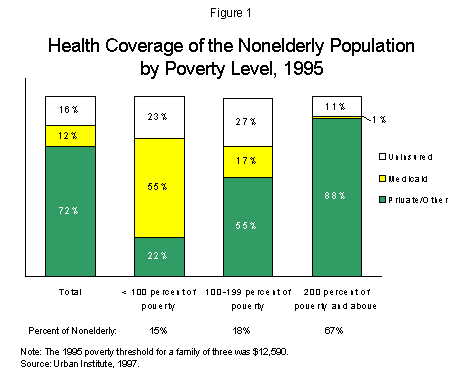
Near-poor families (those with incomes between 100-199% of poverty) are somewhat worse off than poor families with respect to health insurance coverage. Affordable private health insurance is only available to individuals in near-poor families if it is employer-sponsored. Only 55% of individuals in near-poor families had private (primarily employer-sponsored) insurance in 1995, compared to 88% of individuals in families with incomes above 200% of poverty. For certain groups, such as pregnant women and children, Medicaid has played a strong role, but Medicaid's income and categorical restrictions result in limited coverage of the near-poor–only 17% of individuals in near-poor families had Medicaid coverage. As a result, 27% were uninsured [See Figure 1].
Lack of insurance does not mean that the poor and near-poor are not working. Rather, the vast majority of the uninsured are workers or are in working families. In 1995, most uninsured adults and children–79 percent–lived in families where there was at least one full-time worker. Another 11% lived in families where there was at least one part-time worker. Only 10% of the uninsured lived in families where there were no employed adults [Figure 2]. The same is true even of the poor and near-poor uninsured. Among the near-poor, the proportion of uninsured who are in full-time workers' families (83 percent) is nearly as high as among higher income workers (92 percent). The differences in their insurance coverage are therefore not explained by substantially different levels of employment.
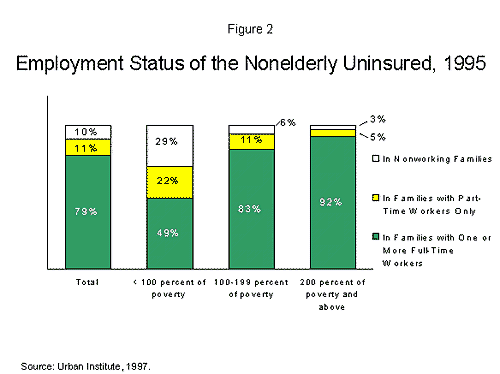
Although Medicaid's coverage of the near-poor is limited by its eligibility criteria, many working families do qualify for Medicaid. About half of Medicaid's nonelderly beneficiaries (low-income, working age adults and children) are in working families. In 1995, 18% of Medicaid's nonelderly beneficiaries were in families where the family head worked full-time and full-year, while 34% were in families where at least one adult worked part-time or part-year [Figure 3].
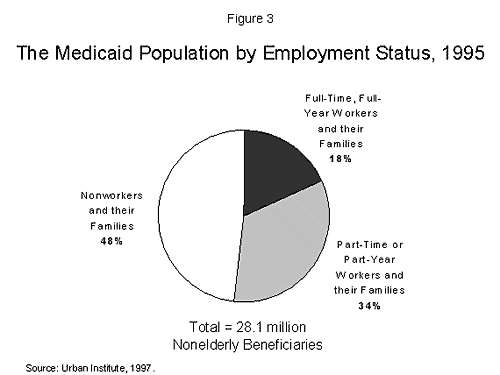
Why Don't Low-Income Families Have Employer Coverage?
Since most of the uninsured and half of low-income adults and children with Medicaid coverage are in working families, an important question is why so many low-income working families lack employer coverage. There are a number of factors associated with jobs without health care coverage, but a key factor is low wages. Figure 4 presents data on employer coverage rates for workers differentiated by wage.2 These data show there is a strong positive relationship between wages and health insurance coverage. In 1996, 90% of workers who earned more than $15 per hour had employer coverage, while only 42% of workers who earned less than $7 per hour had employment-related health insurance.
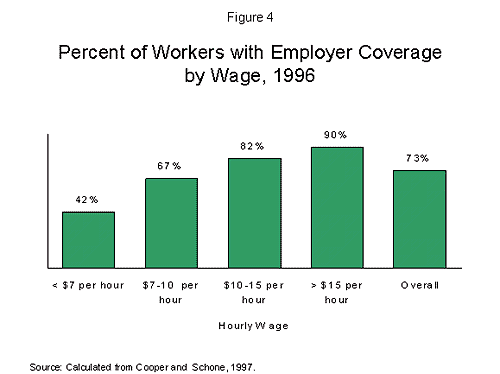
The primary problem for low-wage workers is that their employers not only pay them low wages, but they also offer them lower nonwage compensation-including health insurance and pensions.3 In 1996, only 43% of workers who earned less than $7 per hour were offered health benefits by their employer, compared to 93% of workers who earned more than $15 per hour [Figure 5].
Uninsured low wage workers, like all uninsured workers, are in large as well as small firms, and are in firms that offer coverage to none of their workers as well as firms that offer coverage to some. Although data make it difficult to distinguish precisely between these categories, an estimate from available data suggests that uninsured workers are about equally split between firms that do not offer coverage and firms that offer coverage to some workers.4
Unfortunately, many low-wage employees offered limited benefits do not have alternative access to employment-based coverage through a spouse or other family member. Even when other sources of insurance are taken into account, the gap between low and high-wage workers is still quite large. In 1996, 55% of low-wage workers had access (through their own employer or a family member's employer) to employer coverage, compared to 96% of high-wage workers [See Figure 5].
How Well Does the Employment-Based Health Insurance System Work for Low-Income Families?
Policy Brief Part 1 Part 2 Part 3


